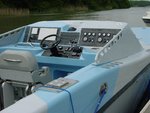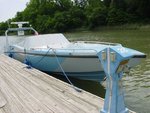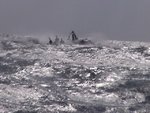lesofprimus
Brigadier General
The Mk V Special Operations Craft is a high-speed waterborne transporter for naval special operations forces. Capable of speeds in excess of 50 knots and ranges of 500 nautical miles, the Mk V was specially designed to get Navy SEALs and other special warfare forces close into shore an a low to medium-threat environment. The Mk V is the result of a newer, streamlined aquisition process that cut red tape; the Navy took position of their first Special Operations craft 18 months after drawing up the original contract.
The Vietnam War highlighted the US Navy's need for better abilities within the littoral, or near-shore, environment, but the drawdowns after the war left the Navy Special Warfare barely existing. There was hardly enough money to keep the old equippment they had running, let alone create new ones. After Desert One awareness of special operations units and their requirements for success increased, and with it came organization, direction, and funding.
One of the (things) lacked was for a fast craft that could use high speed to get in and out of danger quickly dropping forces off in enemy territory or performing raids. The original to carry out this mission was the HSB, or High Speed Boat, which saw use with the Special Boat Units and SEALs in the Gulf War. The HSB was prone to breakdowns however, and, being based on a civilian design, lacked the room to carry enough operators or their equipment. As such, it was decided to create an all-new military designed boat that was exactly what the Navy needed.
What emerged was the Mk V Special Operations Craft, a fast boat with the capacity needed and the ability to get special warfare forces to their destination in comfort so that they are mentally and physically able to perform at their best. The Mk V is manueverable and fast, with a top speed at around 50 knots and the ability to turn quickly and go from full-speed to a dead stop within one and a half times the length of it's hull (roughly 120 feet). It has the capacity to carry sixteen fully equipped SEALs and 4 CRRC's to missions 500 miles away from where they are based.
The Mk V has many special features that makes it more survivable and likely to survive a mission while delivering soldiers to their missions. It's angular design and low sillouette reduces it's radar signature making it harder to spot and detect. It's V-hull design gives it good handling qualities in rough water as well as speed and shallow draft (four feet when cruising on-step). Its twin MTU 12-cylinder TE94 Diesel engines give it power and reliability and, coupled with the two K50S waterjets, provides fast acceleration for operations near shore or in shallow waters as well as cutting down on the rooster tail effect that can make fast boats easier to see and track.
Special attention was paid to the crew and passengers of the Mk V. Special Operations Craft; the seat was specially designed to offer maximum comfort in high seas or heavy manuevering, and allows occupants to either stand or sit. In the past a vast majority of the Special Boat unit's vessels relied on the firepower of embarked SEALs to help bolster the defensive and offensive capacities, but the Mk V is a powerful vehicle in its own right, boaasting four mounts on the port and starboard sides (two to a side) for weapons ranging from M-60 machine guns to 40mm grenade launchers and 7.62 miniguns. Stinger surfacce-to-air missiles can also be carried in defense against attacking aircraft.
The Mk V SOC is operated by Special Boat Squadrons One and Two on the east and west coasts. Two twenty boats in inventory are split into 10 two-vessel detachments, with five detachments on the west coast and four on the east, with the last detachment forward deployed to the European theatre. Each detachment consists of two boats and trailers and spares for 90 days, two 5-ton trucks for towing, and four HMMVV's, and can be deployed to anywhere in the world within 48 hours via USAF C-5 Galaxy cargo aircraft. Each detachment deploys with ten crew and eight maintenance crewmembers.
Small Boat Units (SBU's) were heavily used in the first Gulf War as part of NSWTG-C (Naval Special Warfare Task Group -Central), a combined SEAL/SBT and Joint Communications Unit and were headquartered in Dhahran, Saudi Arabia. Three detachements deployed, including five HSB's (High Speed Boats, both Fountain 34' and Setton craft) and RIBs. The HSB's were used operationally for the first time and worked well for the long patrols and insertions they had been designed for. Missions that the SBU's performed ranged from night interdictions preventing Iraqi forces from infiltrating into Saudi Arabia to a feint designed to cause the Iraqi Army to deploy forces away from the frontline to the coastlines where they would be out of the way (This was a joint SEAL/SBU op). Following Desert Shield/Storm the boat units stayed on and helped retrain and rebuilt the Kuwaiti Navy.
Special Boat Units saw service in Operation Enduring Freedom, helping blockade and invasion forces operating in the waters off of Pakistan. SBT-20 had members attached to HMAS Kanimbla (LPA 51) in January (at least) where they performed "Maritime Interdiction Operations" as well as HMS Illustrious (R 06) in February 2002. Several members were also deployed to Afghanistan to help run the tactical operations center for Task Force K-bar.
Statistics
Length Overall 82 ft.
Beam, maximum 17.5 ft.
Draft (max. static) 5 ft.
Displacement 57+ tons in operational configuration
Speed 50 knots
Hull Design Mono hull, 5086 series aluminum
Propulsion Engines 2 x 2285 HP MTU 12V396 TE94 engines
Propulsor 2 x KaMeWa K50S Waterjets
Fuel Capacity 2600 gallons fuel capacity
Nav System Radar, GPS, LORAN, chart plotter, fathometer, flux gate compass
Communications Systems VHF-BTB, VHF-FM, UHF/VHF-FM UHF AM/FM, LOS/SATCOM, VHF-High Band, HF, UHF-handheld, data, IFF
Accommodations 5 crew; up to 16 passengers and up to 4 CRRC + 6 outboard motors and fuel
Builder Halter Marine Inc., Gulfport, Miss.
Weapons Load 5 mounting positions for 7.62 mm machine guns or miniguns, .50 Cal heavy machine guns, 40mm grenade launchers; improvements include 7.62mm gatling guns, twin .50 Cal, 25mm guns, STINGER Surface-to-Air Missiles
The Vietnam War highlighted the US Navy's need for better abilities within the littoral, or near-shore, environment, but the drawdowns after the war left the Navy Special Warfare barely existing. There was hardly enough money to keep the old equippment they had running, let alone create new ones. After Desert One awareness of special operations units and their requirements for success increased, and with it came organization, direction, and funding.
One of the (things) lacked was for a fast craft that could use high speed to get in and out of danger quickly dropping forces off in enemy territory or performing raids. The original to carry out this mission was the HSB, or High Speed Boat, which saw use with the Special Boat Units and SEALs in the Gulf War. The HSB was prone to breakdowns however, and, being based on a civilian design, lacked the room to carry enough operators or their equipment. As such, it was decided to create an all-new military designed boat that was exactly what the Navy needed.
What emerged was the Mk V Special Operations Craft, a fast boat with the capacity needed and the ability to get special warfare forces to their destination in comfort so that they are mentally and physically able to perform at their best. The Mk V is manueverable and fast, with a top speed at around 50 knots and the ability to turn quickly and go from full-speed to a dead stop within one and a half times the length of it's hull (roughly 120 feet). It has the capacity to carry sixteen fully equipped SEALs and 4 CRRC's to missions 500 miles away from where they are based.
The Mk V has many special features that makes it more survivable and likely to survive a mission while delivering soldiers to their missions. It's angular design and low sillouette reduces it's radar signature making it harder to spot and detect. It's V-hull design gives it good handling qualities in rough water as well as speed and shallow draft (four feet when cruising on-step). Its twin MTU 12-cylinder TE94 Diesel engines give it power and reliability and, coupled with the two K50S waterjets, provides fast acceleration for operations near shore or in shallow waters as well as cutting down on the rooster tail effect that can make fast boats easier to see and track.
Special attention was paid to the crew and passengers of the Mk V. Special Operations Craft; the seat was specially designed to offer maximum comfort in high seas or heavy manuevering, and allows occupants to either stand or sit. In the past a vast majority of the Special Boat unit's vessels relied on the firepower of embarked SEALs to help bolster the defensive and offensive capacities, but the Mk V is a powerful vehicle in its own right, boaasting four mounts on the port and starboard sides (two to a side) for weapons ranging from M-60 machine guns to 40mm grenade launchers and 7.62 miniguns. Stinger surfacce-to-air missiles can also be carried in defense against attacking aircraft.
The Mk V SOC is operated by Special Boat Squadrons One and Two on the east and west coasts. Two twenty boats in inventory are split into 10 two-vessel detachments, with five detachments on the west coast and four on the east, with the last detachment forward deployed to the European theatre. Each detachment consists of two boats and trailers and spares for 90 days, two 5-ton trucks for towing, and four HMMVV's, and can be deployed to anywhere in the world within 48 hours via USAF C-5 Galaxy cargo aircraft. Each detachment deploys with ten crew and eight maintenance crewmembers.
Small Boat Units (SBU's) were heavily used in the first Gulf War as part of NSWTG-C (Naval Special Warfare Task Group -Central), a combined SEAL/SBT and Joint Communications Unit and were headquartered in Dhahran, Saudi Arabia. Three detachements deployed, including five HSB's (High Speed Boats, both Fountain 34' and Setton craft) and RIBs. The HSB's were used operationally for the first time and worked well for the long patrols and insertions they had been designed for. Missions that the SBU's performed ranged from night interdictions preventing Iraqi forces from infiltrating into Saudi Arabia to a feint designed to cause the Iraqi Army to deploy forces away from the frontline to the coastlines where they would be out of the way (This was a joint SEAL/SBU op). Following Desert Shield/Storm the boat units stayed on and helped retrain and rebuilt the Kuwaiti Navy.
Special Boat Units saw service in Operation Enduring Freedom, helping blockade and invasion forces operating in the waters off of Pakistan. SBT-20 had members attached to HMAS Kanimbla (LPA 51) in January (at least) where they performed "Maritime Interdiction Operations" as well as HMS Illustrious (R 06) in February 2002. Several members were also deployed to Afghanistan to help run the tactical operations center for Task Force K-bar.
Statistics
Length Overall 82 ft.
Beam, maximum 17.5 ft.
Draft (max. static) 5 ft.
Displacement 57+ tons in operational configuration
Speed 50 knots
Hull Design Mono hull, 5086 series aluminum
Propulsion Engines 2 x 2285 HP MTU 12V396 TE94 engines
Propulsor 2 x KaMeWa K50S Waterjets
Fuel Capacity 2600 gallons fuel capacity
Nav System Radar, GPS, LORAN, chart plotter, fathometer, flux gate compass
Communications Systems VHF-BTB, VHF-FM, UHF/VHF-FM UHF AM/FM, LOS/SATCOM, VHF-High Band, HF, UHF-handheld, data, IFF
Accommodations 5 crew; up to 16 passengers and up to 4 CRRC + 6 outboard motors and fuel
Builder Halter Marine Inc., Gulfport, Miss.
Weapons Load 5 mounting positions for 7.62 mm machine guns or miniguns, .50 Cal heavy machine guns, 40mm grenade launchers; improvements include 7.62mm gatling guns, twin .50 Cal, 25mm guns, STINGER Surface-to-Air Missiles




